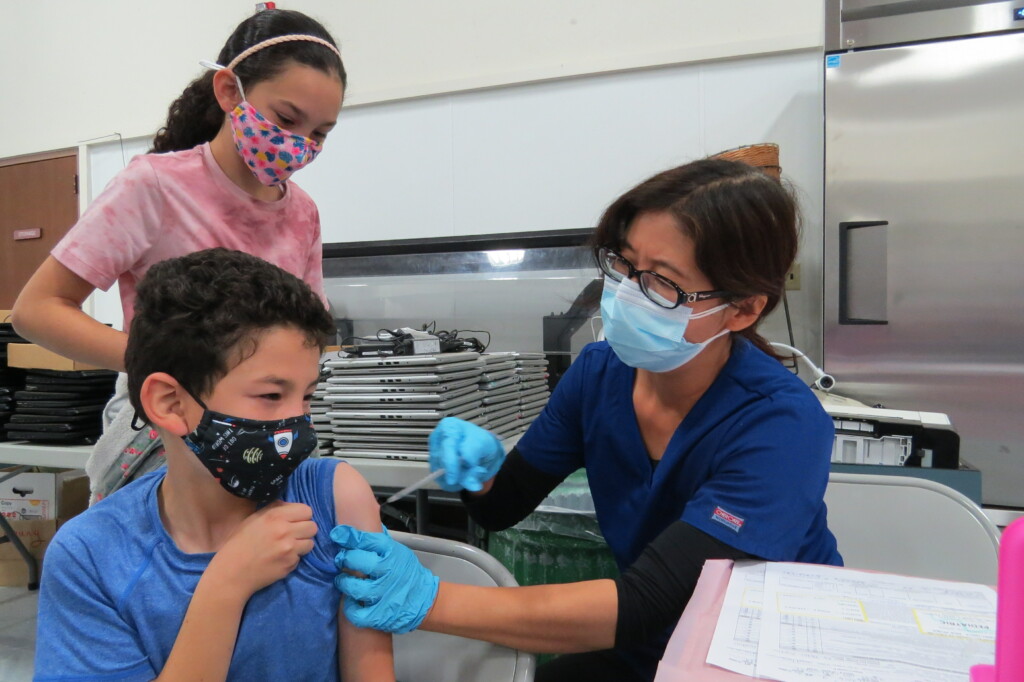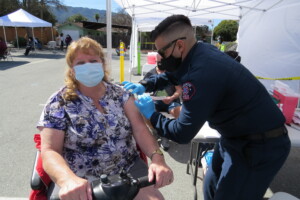Health: Omicron past ‘peak,’ Cody says; county updates its mask policy
County releases more than 20,000 free at-home COVID-19 tests

Photo by Marty Cheek
Los Paseos Elementary School student Yacin receives a COVID-19 shot from nurse Helen Shi, while his sister, Noor, watches.
By Staff Report
Two years to the day when on Jan. 31, 2020, Santa Clara County officially began a long fight for public health against the COVID-19 pandemic, officials say the battle continues with the Omicron variant.

Photo by Marty Cheek
Linda Clark, a resident of Wheeler Manor, receives a COVID-19 vaccine shot from a Gilroy firefighter at Gilroy Senior Center Feb. 17.
More than 1.6 million county residents, or 83.5 percent, have been vaccinated, and more than 900,000, or 63.8 percent, have received a booster shot, according to the Public Health Department’s online dashboard. As a result, the current case rate has dropped by about half, said county public health director, Dr. Sara Cody.
In an online “town hall” meeting hosted by Congressman Ro Khanna on Jan. 25, Cody said the more contagious Omicron is the dominant variant in the county since it arrived in early December.
About 95 percent of the cases now in the county are Omicron. Cody noted the county is starting to see several cases of the sub-variant of Omicron, BA.2, which is slightly more contagious.
“The Omicron wave really took us by the collar and sent us spinning rapidly at the time,” Cody said. “Starting today, I am pleased to say that we are past the peak. It looks like it probably happened somewhere between the seventh and tenth of January. And we’re just beginning to see early signs that our hospitals may be seeing a little bit of a reprieve.”
 Many county residents are exhausted by the two-year slog of COVID-19, but they must resist becoming complacent in taking action to preserve their health, she said.
Many county residents are exhausted by the two-year slog of COVID-19, but they must resist becoming complacent in taking action to preserve their health, she said.
“The road ahead comes with a lot of uncertainty,” she said. “We’ve been through five waves locally. I imagine there will be more waves to come. It comes in peaks and valleys and what we don’t know is what the next peak will look like.”
Getting vaccinated, wearing masks and getting tested can make a difference in stopping the spread of COVID-19. Last month, the county offered limited additional free at-home COVID-19 antigen tests to people who live, work, or attend school in the county. More than 20,000 tests have been distributed.
“We are glad to provide additional at-home tests for our community at a time when testing is still very important,” said Miguel Márquez, chief operations officer for the county. “When people have the opportunity to test, it allows everyone to limit the spread of the virus.”
The county opted to purchase and distribute the tests due to the scarcity of tests and enormous demand. Additional tests are being distributed through the county’s outreach teams to disproportionately impacted communities, through nonprofit partner organizations, as well as to first responders and other essential workers.
In other local COVID-19 news, Public Health Department officials decided Feb. 9 not to lift local indoor masking requirements when the state of California lifts its indoor masking requirement in mid-month. Santa Clara County will continue to base decisions on whether and when to lift indoor masking requirements on the risks posed by COVID-19, using clearly defined metrics related to vaccination, hospitalizations, and case rates. Los Angeles County will also not immediately lift its local masking requirement. County officials anticipate they will be able to lift indoor masking requirements in a matter of weeks, as case rates continue to decline.
“We must continue to base our decisions on the risks COVID-19 presents to our community, and we look forward to lifting the indoor mask requirement as soon as we can do so without putting vulnerable people at undue risk,” Cody said in a Feb. 9 press release. “In the meantime, we need to continue to do what’s needed to keep our community protected. Indoor masking is critical to protect our community, especially members who are older or immunocompromised. Continuing to mask indoors should also allow our case rates to continue to drop quickly.”
While a growing number of states are dropping mask mandates, Centers for Disease Control data on COVID-19 transmission rates indicate that more than 99 percent of U.S. counties should keep covering up, according to CDC Director Rochelle Walensky. In several interviews she said that “now is not the moment” to drop the precautions. The CDC suggests wearing masks in places where the new case rate is higher than 50 cases per 100,000 or the testing positivity rate exceeds 8 percent.
The county also updated its prior metrics, which were adopted when the Delta variant was circulating last year, to reflect the fact the current Omicron variant poses less risk of severe illness and hospitalization than Delta. Specifically, the county’s prior metrics required that the seven-day average of new cases be about 150 or below based on CDC’s moderate criteria. The updated metrics allow indoor masking requirements to be lifted when the county’s seven-day average of new cases is 550 or below for at least a week.
The county has already met one of the three metrics for lifting the indoor masking requirement — that 80 percent of residents are fully vaccinated. The two remaining metrics are not yet met. The local indoor masking requirement will be lifted when the remaining two metrics are met:
While overall rates have declined significantly since their January peak, COVID-19 continues to circulate widely. Case rates are still higher than at any other time in the pandemic prior to the January Omicron peak. The county’s current seven-day average case count is 1,922 cases per day, which is in the CDC’s highest level of transmission. Hospitalization rates likewise remain high, and are not yet falling.
The state will be lifting its universal indoor masking requirement Feb. 16. However, state health orders will continue to require universal indoor masking in many settings after that date, including all K-12 schools, childcare facilities, public transit, healthcare facilities, shelters, jails, and long-term care facilities.

